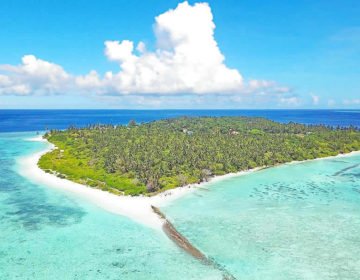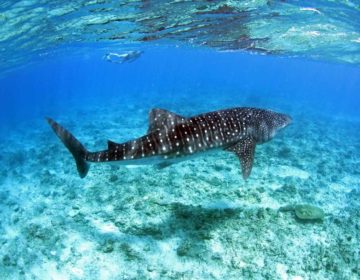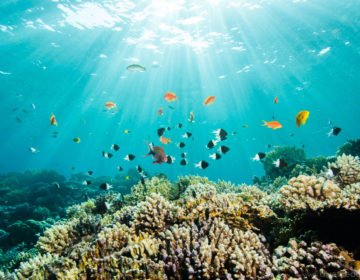The north and east sides of South Maalhosmadulu Atoll have many islands, reefs, and channels, providing countless alternative diving locations. The western side of the atoll is characterized by wide channels and big reefs with few islands or landmarks. There are around 20 channels on the eastern side and nine on the western side. A 1.8-kilometer-wide channel, Kuda Kanduolhi, cuts through South Maalhosmadulu Atoll from east to west. There are steep drop-offs into this 200-meter-deep channel and some interesting diving. Many of the islands have sections of the reef with excellent coral growth making them ideal for diving and snorkeling.

The inside of the atoll has depths mostly between 30 and 50 meters, and there are many thilas, mostly between seven and 10 meters. There are excellent sand and rubble zones in the more accessible parts of the atoll floor and many impressive coral heads.
This atoll is popular with liveaboards venturing to the northern regions both as a final destination and for stop-overs. There are several resorts in the atoll spread evenly down the eastern side, and one on Landaa Giraavaru. In Goidhoo Atoll, there is only one channel in the south of the atoll, the two-kilometer-wide Doru Kandu, with excellent diving on the outside corners. On the inside of the atoll, it is deep the center but closer to the islands and reefs are vast expanses of shallow sand with many reef flats and coral heads. On the outside of Goidhoo Atoll, the structure of the reef is hard and flat as a result of its exposure to rough seas.
 Landaa Giraavaru Resort
Landaa Giraavaru Resort
Bathalaa
One of the most brilliant sights in the atoll occurs on the outside northern corner of Vinaneiy Faru, where a dazzling display of pink coral clings to the vertical channel wall. The sand islet of Vinaneiyfaruhuraa is on the corner and marks the starting point for the dive. The reef slopes smoothly to a cliff face at 18 meters and then drops vertically to the channel bottom at 25 meters. All along this wall are isolated patches of pink coral interspersed with sea fans, black coral and soft corals. There are a couple of pink coral locations inside the channel, but the better part of it occurs on the corner over a distance of about 100 meters. The hard coral wall and bottom have many encrusting sponges, as well as several gorgonians and black coral species, making this wall a kaleidoscope of colors.
Diving Hints
Take care not to break or damage the pink coral when drifting with a current.
 Bathalaa
Bathalaa
Voavah
A secure coral-ringed anchorage on the west side of this small uninhabited island makes this a potentially exciting night dive location. It could be well called ‘goby lagoon’ because of their vast number and variety, even less commonly seen species. The inside of the lagoon s covered in zoanthids, a small anemone-like coelenterate that appears to have taken over the reef. As a consequence, perhaps, fish life is sporadic inside, although on the outside entrance to the lagoon is home to schools of blue-striped snapper, red bass, and butterfly fish occur. There is a narrow band of sea grass about 50 meters long, in very shallow water close to the island. The white-blotch razorfish can often be seen near this small patch and elsewhere around the sand slopes.
 The inside of the lagoon s covered in zoanthids, a small anemone-like coelenterate.
The inside of the lagoon s covered in zoanthids, a small anemone-like coelenterate.
Landaa Giraavaru
On the outside corner of Landaa Giraavaru is a long, narrow reef with very lovely hard coral on the reef top. Large fish are prevalent at this site with regular sightings of stingrays and Napoleon fish.
Landaa Giraavaru Lagoon
Diving inside the lagoon from an anchored boat is the perfect way to finish off a day of diving. Safari dhonis can anchor in 13 meters close to a sand slope on the south side of the island. Nearby, a coral reef rises to two meters, and all over the sandy bottom, coral boulders and staghorn coral attract a wealth of fish life. Some coral boulders rise to three meters. Night diving is excellent and ideal for photographers. Fusiliers, butterflyfish, cardinalfish, snapper, and sometimes swarming schools of catfish can be seen all night. The slopes are peppered with the holes of gobies, and flatworms and nudibranchs are more likely to be seen here than at many other places. Much of the coral is covered with thin, floppy fan sponges and underneath are slender sponge reef gobies.
 Underneath the coral are slender sponge reef gobies.
Underneath the coral are slender sponge reef gobies.
Kamadhoo
Kamadhoo is a quiet island reef dive with a healthy coral reef top and considerable variation in fish life. On the western side are numerous basslet, wrasse, clown triggerfish, blue triggerfish, and hawkfish. There are also many sea whips with feather stars attached, and small shrimps can be seen on the whips. This dive is a pleasant change and ideal for photographers.
 On the western side are numerous hawkfish.
On the western side are numerous hawkfish.
THE MAALHOS REGION
Aidhoo
The reef on the north side of the small island of Aidhoo is a great location to view fish of every description including tuna, snapper, and Napoleon. On the outside reef are large schools of trevally and sweetlips as well as honeycomb moray eels and plenty of turtles.
 On the outside reef are large honeycomb moray eels.
On the outside reef are large honeycomb moray eels.
Bodu Thila
Bodu Thila is a very large thila with an impressive landscape and the top around eight meters. There is soft coral on the reef faces, and fish life is abundant, including grey reef sharks, large schools of fusilier, stingrays and sometimes manta rays. Turtles are regular visitors, and ghost pipefish can be seen among the branches of gorgonians.
 Ghost pipefish can be seen among the branches of gorgonians.
Ghost pipefish can be seen among the branches of gorgonians.
Dhonfanu Thila (Kuda Thila)
Dhonfanu Thila (Kuda Thila) is a smaller thila with excellent hard coral on the reef top and soft coral on the walls. There are big trevally, schools of blue-striped snapper, and tuna and on the bottom at around 35 meters are stingrays.
Dhigu Thila
Dhigu Thila is a long, narrow thila about 200 meters long with the top between six and 11 meters. At the eastern end is a sharp drop-off from seven to 25 meters and a large cave at 13 meters with black coral. Around the corner on the north side are a series of spectacular caves stacked vertically down the reef. Nearby and usually visible from the main reef is a flat-topped outcrop of reef 15 meters wide at a depth of 26 meters. Huge schools of red bass, trevally, and other fish congregate at the end of the thila and as the current picks up, so too does the feeding activity. Along the southern side, mostly between 20 and 25 meters, are big bright caves with sea fans and whips, many grouper, squirrelfish, and lots of smaller fish like white-banded possum wrasse and pipefish. On the sandy bottom around the thila, black-spotted stingrays can often be seen. The reef top is covered in beautiful hard coral with stands of fire coral on the highest point in the eastern end.
 White-banded possum wrasse.
White-banded possum wrasse.
Diving Hints
The thila lies in an east to west direction, and current usually flows the same way. To gain full advantage of the scenery, it may be necessary for divers to start in open water well upstream from the thila when there is a strong current. The options are to dive either the south or north sides with the south side offering the best in the way of caves and scenery. This poses a slight problem if the current is flowing from the east and divers wish to view the caves on the north-east corner. There is not a lot of protection from the current at shallow depth so divers should be fully prepared to make an open water safety stop.
Dharavandhoo Thila
The beauty of this thila is its unusual features. It begins as a narrow ridge from the island of Dharavandhoo and extends, like a roller-coaster, for over 200 meters with the top between five and 17 meters. Along its course, it leaves a trail of reef outcrops, steep ledges, colorful caves, sand slopes, and narrow crevices. In some crevices and caves are sea fans, whips, and black coral bushes and some big grouper. There are bright yellow and orange sponges pink sea stars, pin cushions, and sea cucumbers. Also, great opportunities for photographers to take stunning landscape shots.

Maalhoss
Divers will be delighted with the variety of marine life that is concentrated on the west side of Maalhoss. Twenty meters to the south of the lagoon entrance, the reef wall bends out and drops off to 25 meters before leveling off to a bottom of coral rubble and sand. Caves are liberally sprinkled down the face of the wall. At this point the fish life is interesting. There are many different species of cardinalfish and occasionally a comet fish – uncommon in the Maldives – can be seen.
There is black coral and in some caves are lobsters and shrimp. On the deeper slopes among the sand and rubble are many rare species of goby. At this unique location is another rare fish, the snowflake soapfish, Pogonoperca ocellata. At the northern end, in Hibalhidhoo Kandu, the current can be quite strong and attracts schooling needlefish, halfbeaks, and herring. This dive is an ideal site for enthusiastic fish watchers.
 At this unique location is the rare snowflake soapfish, Pogonoperca ocellata.
At this unique location is the rare snowflake soapfish, Pogonoperca ocellata.
EYDHAFUSHI REGION
Dhigali Haa (Horubadhoo Thila) – PROTECTED MARINE AREA
This site was heavily fished for shark in the past and is now a protected marine area. It is a good shark viewing location with six or more grey reef sharks circling at any one time. Fish life is varied with bluefin jacks, fusilier, blue-striped and humpback snapper, batfish, schools of barracuda and eagle rays in the open water. Closer to the reef are lionfish, angelfish, basslets, and trumpet fish. In the caves and around the reef edges are black coral bushes, oyster clams, yellow sea fans, sponges and soft corals. This is a small thila, easily circumnavigated in one dive and is a favorite site for shark viewing by Soneva Fushi guests. Fish life also includes trevally, fusilier, batfish, small schools of barracuda and sometimes eagle rays.
Click here to book a stay at the Soneva Fushi Resort.
 Soneva Fushi Resort
Soneva Fushi Resort
Kunfunadhoo Corner
The entrance to Kunfunadhoo Kandu attracts plenty of pelagic action and on the outside corner of Kunfunadhoo is a nice reef featuring some Napoleon. When the current is flowing into the atoll, a small school of up to five eagle rays often appear near the corner.
Eydhafushi
The outside reef of this island offers the best diving, and it is a convenient site for Sonevafushi divers during the south-west monsoon season. Turtles and schools of fusilier are common. The channels on either side of the island are less impressive.
 Turtles are common.
Turtles are common.
Maadhoo Corner
The northeast side of the island reef offers the most interesting diving. When the current is flowing into the atoll, it is more difficult to dive because the water flow splits in two directions around the reef. There are nice overhangs on the corner and very good fish life. On the reef top further inside Maadhoo Kandu are excellent table corals.
INNAFUSHI REGION
Nelivaru Thila
Nearby the island of Nelivarufinolhu is a large reef with good diving for all levels of divers. There are nice corals, rocks and caves, especially on the north side. Fish life includes snapper, tuna, turtles, and mantas. One of the notable features of this site are the scorpion fish – observe the reef, and many can be seen.
 One of the notable features of this site are the scorpion fish.
One of the notable features of this site are the scorpion fish.
Maadhoo Giri
This is a dive for both beginners and experienced divers. On the west corner of the reef is a chimney with the top opening at three meters and the bottom at 20 meters. Anglerfish, one pink and another black, can be seen if divers are observant and lucky enough. At 30 meters is a large school of blue-striped snapper. East of the corner are large coral rocks, overhangs, and three small pink corals. There is also black coral, and sometimes ghost pipefish can be seen.
Hulhudhoo
On the northeast side of the island are very good soft and hard corals. Napoleon fish and turtles are regular attractions here.
Mirandhoo Thila
On the south side of Miriandhoo is a small, deep thila for experienced divers only. The top is covered in soft coral, and the isolation of the site attracts a diverse range of marine life. Turtles and eagle rays are drawn here.
 Turtles and eagle rays are drawn here.
Turtles and eagle rays are drawn here.
Ohgali Haa
This is a large reef with interesting overhangs on the northeast side. There are schools of batfish, some tuna and on the reef top are leaf fish.
Kudadhoo Corner
At the entrance to Maavihaa Kandu, Kudadhoo Corner offers all the usual range of fish life seen at many of the channel entrances. Among them are Napoleon fish, lobster, nurse sharks, and turtles.
Naamuli Wreck
The reef on the western of Goidhoo Atoll is called Naamuli Faru and literally means shipwreck reef. There is a wide reef flat at the western tip of the atoll and on the top in five meters, lies the flattened remains of an old steel ship. The main body of the coral covered wreck covers a distance of about 30 meters. The steel remains have been completely broken up by heavy seas, and some rib sections are spread over the reef for a distance of up to 50 meters. The highest point of the wreck is at two meters and the deepest at seven meters. Like most wrecks, it offers good protection for fish and attracts many wrasse, surgeon, fusilier, angelfish, and emperor. A special feature here which can be found in little burrows on the reef top are many orange-spotted blennies.
 A special feature here which can be found in little burrows on the reef top are many orange-spotted blennies.
A special feature here which can be found in little burrows on the reef top are many orange-spotted blennies.
The origins of the Naamuli wreck remain a mystery as there is no known record of the ship available. Even old islanders on Fulhadhoo cannot tell when the ship was wrecked. When it was located some years ago, the wreck was thought to be the remains of the Corbin and because of its supposed historical value divers were banned from going anywhere near it. However, the steel remains indicate it is not that of the Corbin, and it is hoped that further archaeological research will uncover the true origins of the wreck.
(Source: Dive Maldives: A guide to the Maldives Archipelago. Tim Godfrey. Atoll Editions)



